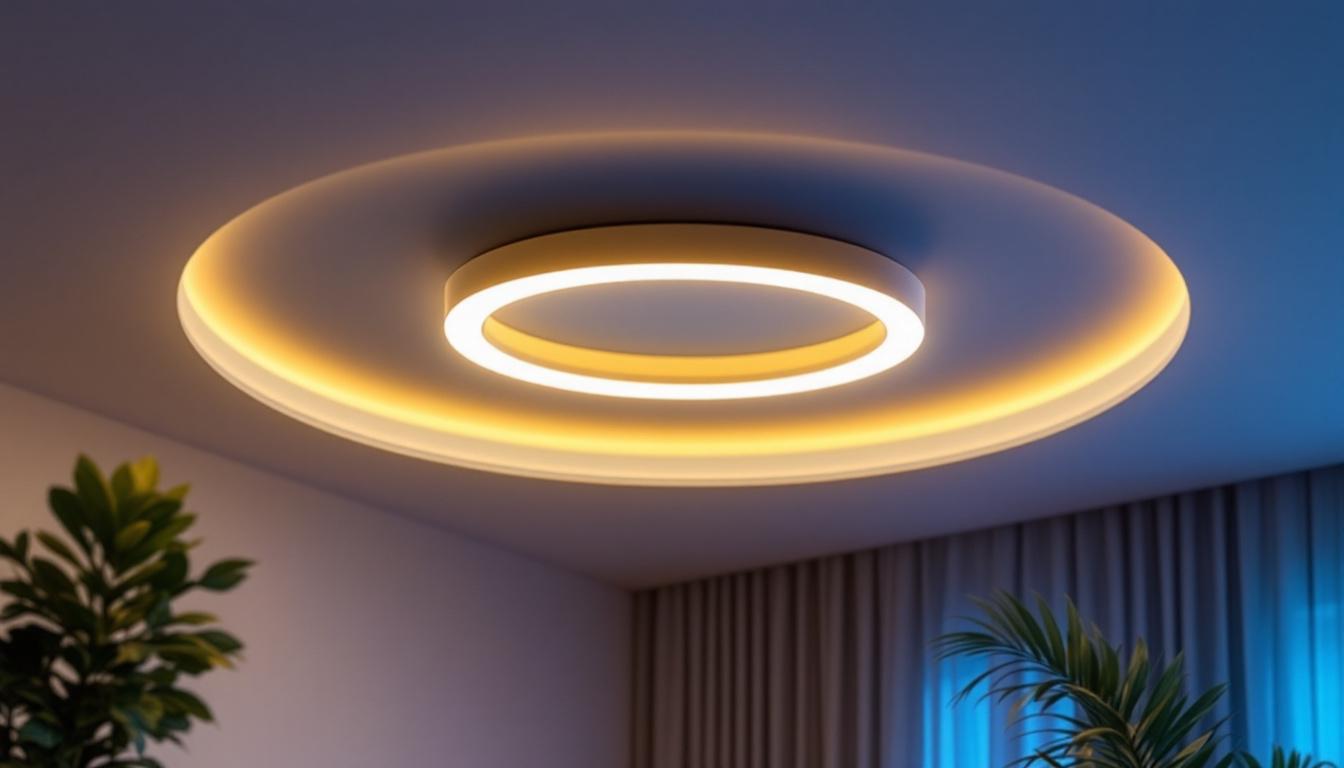
In the realm of interior design and home improvement, ceiling fan lights have emerged as a popular choice among homeowners and contractors alike. These fixtures combine the functionality of a ceiling fan with the aesthetic appeal of integrated lighting. For lighting contractors, understanding the advantages and disadvantages of fan lights can help in making informed recommendations to clients. This article delves into the pros and cons of ceiling fan lights, providing insights that can enhance project outcomes and customer satisfaction.
Ceiling fan lights are fixtures that combine the cooling benefits of a ceiling fan with integrated lighting options. They are designed to provide both illumination and air circulation, making them a versatile choice for various spaces. Available in a myriad of styles, sizes, and finishes, fan lights can cater to diverse tastes and preferences.
These fixtures often come with multiple light settings, allowing homeowners to adjust the brightness according to their needs. Additionally, many modern fan lights are equipped with energy-efficient LED bulbs, which contribute to lower energy costs and reduced environmental impact. The integration of smart technology in some models also allows for remote control and scheduling, enhancing convenience and user experience.
One of the most appealing aspects of ceiling fan lights is their design versatility. They can seamlessly integrate into various interior styles, from contemporary to traditional. This adaptability allows lighting contractors to offer clients a wide range of options that align with their design vision. For instance, sleek, minimalist designs may appeal to those with modern aesthetics, while ornate, vintage-inspired fixtures can complement more classic interiors.
Furthermore, ceiling fan lights are available in different sizes, ensuring that they can fit into both spacious living areas and smaller rooms. This flexibility is crucial for contractors who aim to meet the specific needs of each project. Beyond size, the choice of materials—such as wood, metal, or glass—can also influence the overall ambiance of a room, allowing for personalized touches that reflect the homeowner’s style.
Energy efficiency is a significant advantage of ceiling fan lights. Many models utilize LED technology, which consumes less power compared to traditional incandescent bulbs. This not only reduces electricity bills for homeowners but also contributes to a more sustainable lifestyle. Additionally, the longevity of LED bulbs means less frequent replacements, further enhancing their cost-effectiveness over time.
Contractors can highlight the long-term savings associated with these fixtures, making them an attractive option for clients who are environmentally conscious or looking to minimize their energy expenses. Moreover, ceiling fans can help reduce reliance on air conditioning by providing a cooling breeze, which can be particularly beneficial in warmer climates. By promoting the dual functionality of these fixtures, contractors can effectively communicate their value to potential clients, emphasizing both comfort and efficiency in home design.
Ceiling fan lights offer several benefits that can enhance the overall appeal of a home. Understanding these advantages can help lighting contractors effectively communicate their value to clients. Below are some of the key pros associated with fan lights.
The primary advantage of ceiling fan lights is their dual functionality. They provide both cooling and illumination, making them an efficient choice for various spaces. In warmer climates, ceiling fans can help circulate air, creating a comfortable environment while reducing reliance on air conditioning.
This dual purpose is particularly appealing to homeowners looking to maximize the utility of their fixtures. Lighting contractors can emphasize this benefit when discussing options with clients, showcasing how fan lights can enhance comfort and convenience. Additionally, many modern ceiling fan lights come equipped with energy-efficient LED bulbs, which not only provide bright, long-lasting illumination but also contribute to lower energy bills. This eco-friendly aspect can be a significant selling point for environmentally conscious clients.
In smaller homes or apartments, space can often be at a premium. Ceiling fan lights serve as a space-saving solution by combining two essential features into one fixture. Rather than installing separate lighting and ceiling fans, homeowners can achieve both functionalities with a single installation.
This not only saves space but also simplifies the overall design of a room. Contractors can leverage this advantage when working with clients who have limited space, providing them with an efficient and stylish solution. Furthermore, the installation of ceiling fan lights can help eliminate the clutter of multiple fixtures, creating a more streamlined and open atmosphere. This is particularly beneficial in rooms where every square foot counts, such as studio apartments or cozy bedrooms.
Ceiling fan lights come in a variety of styles and finishes, allowing homeowners to choose fixtures that complement their interior decor. From sleek modern designs to more ornate traditional options, there is a fan light to suit every taste.
By offering a wide selection of designs, lighting contractors can help clients find fixtures that enhance the overall aesthetic of their spaces. This attention to design can significantly impact a homeowner’s satisfaction and the perceived value of their property. Additionally, many ceiling fan lights now incorporate smart technology, enabling homeowners to control lighting and fan speed through mobile apps or voice commands. This modern twist not only adds a layer of convenience but also appeals to tech-savvy clients looking to integrate smart home features into their living spaces.
While ceiling fan lights offer numerous benefits, there are also some drawbacks that lighting contractors should consider. Understanding these cons can help contractors provide balanced advice to clients and set realistic expectations.
Installing ceiling fan lights can be more complex than standard light fixtures due to the additional components involved. Contractors may need to ensure that the ceiling structure can support the weight of the fan and that the electrical wiring is adequate for both the fan and the light.
This complexity can lead to longer installation times, which may impact project timelines and costs. Contractors should communicate these potential challenges to clients, ensuring they understand the implications of choosing ceiling fan lights.
Some ceiling fans can produce noise during operation, which may be a concern for homeowners, especially in bedrooms or quiet spaces. While many modern fan lights are designed to operate quietly, there can still be variations in noise levels based on the model and installation quality.
Lighting contractors should be prepared to discuss this issue with clients, offering recommendations for quieter models or installation techniques that can minimize noise. Addressing this concern upfront can help prevent dissatisfaction after installation.
Ceiling fan lights may require more maintenance than traditional light fixtures. Dust and debris can accumulate on the fan blades, potentially affecting performance and aesthetics. Regular cleaning is essential to ensure optimal functionality and appearance.
Contractors should inform clients about the maintenance requirements associated with ceiling fan lights. Providing tips on how to clean and care for these fixtures can enhance customer satisfaction and promote long-term use.
When selecting ceiling fan lights for a project, contractors must consider several factors to ensure they meet the needs and preferences of their clients. Making informed choices can lead to successful installations and satisfied customers.
The size and layout of a room play a crucial role in determining the appropriate ceiling fan light. In larger spaces, a more powerful fan may be necessary to ensure adequate air circulation. Conversely, smaller rooms may require compact models that provide sufficient light without overwhelming the space.
Contractors should assess the dimensions of the room and the height of the ceiling before making recommendations. This consideration will help ensure that the chosen fixture is both functional and aesthetically pleasing.
Understanding the design preferences of clients is essential when selecting ceiling fan lights. Contractors should engage in discussions to determine the desired style, color, and finish that will best complement the existing decor.
By offering a range of options that align with the client’s vision, contractors can enhance the overall satisfaction with the project. This attention to detail can also contribute to positive word-of-mouth referrals and repeat business.
As energy efficiency becomes increasingly important to homeowners, contractors should prioritize ceiling fan lights with high energy efficiency ratings. Models that utilize LED technology not only provide significant energy savings but also have longer lifespans compared to traditional bulbs.
Contractors can educate clients about the benefits of selecting energy-efficient fixtures, helping them make informed decisions that align with their sustainability goals. This knowledge can further enhance the contractor’s reputation as a trusted advisor.
Ceiling fan lights present a unique opportunity for lighting contractors to offer clients a versatile and functional lighting solution. While they come with both pros and cons, understanding these aspects can empower contractors to provide well-rounded advice and recommendations.
By highlighting the dual functionality, energy efficiency, and design versatility of ceiling fan lights, contractors can appeal to a wide range of homeowners. Conversely, being aware of potential installation complexities, noise considerations, and maintenance requirements ensures that clients have realistic expectations.
Ultimately, the choice of ceiling fan lights can significantly enhance the comfort and aesthetics of a home. By carefully considering the needs and preferences of clients, lighting contractors can successfully navigate the pros and cons of these fixtures, leading to satisfied customers and successful projects.
Ready to elevate your lighting projects with the dual functionality and energy efficiency of ceiling fan lights? Look no further than LumenWholesale for a vast selection of spec-grade lighting products at unbeatable wholesale prices. Our commitment to quality and affordability ensures that you can provide your clients with reliable, high-performance lighting solutions that meet the highest industry standards. Plus, with free shipping on bulk orders, you can enjoy the best value without any hidden fees. Make the smart choice for your lighting needs and experience wholesale lighting at the best value with LumenWholesale today.

Discover expert insights and practical tips for lighting contractors on selecting and installing circular LED ceiling lights.

Discover the key differences between T5 and T8 lamps and learn how choosing the right option can significantly save lighting contractors both time and money.

Discover the key qualities that distinguish top lighting contractors in the world of dimmer lighting.

Discover the strategic advantages of bypassing ballasts in lighting projects.